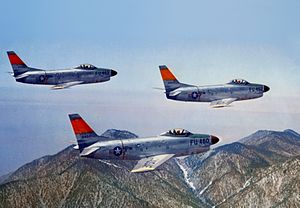F-86L Sabre
| F-86D/K/L Sabre | |
|---|---|
 |
|
| The fifth F-86D for the USAF in formation with two other early production aircraft | |
| Role | Fighter interceptor |
| Manufacturer | North American Aviation |
| First flight | 22 December 1949, 68 years ago |
| Primary users |
United States Air Force Italian Air Force SFR Yugoslav Air Force Venezuelan Air Force |
| Number built | 2,847 |
| Unit cost |
$343,839 (F-86D)
|
| Developed from | North American F-86 Sabre |
The North American F-86D Sabre (sometimes called the "Sabre Dog" or "Dog Sabre") was a transonic jet all-weather interceptor of the United States Air Force and others. Based on North American's F-86 Sabre day fighter, the F-86D had only 25 percent commonality with other Sabre variants, with a larger fuselage, larger afterburner engine, and a distinctive nose radome.
The YF-95 was a development of the F-86 Sabre, the first aircraft designed around the new 2.75-inch (70 mm) "Mighty Mouse" Folding-Fin Aerial Rocket (FFAR). Begun in March 1949, the unarmed prototype, 50-577, first flew on 22 December 1949, piloted by North American test pilot George Welch and was the first U.S. Air Force night fighter design with only a single crewman and a single engine, a J47-GE-17 with afterburner rated at 5,425 lbf (24.1 kN) static thrust. Gun armament was eliminated in favor of a retractable under-fuselage tray carrying 24 unguided Mk. 4 rockets, then considered a more effective weapon against enemy bombers than a barrage of cannon fire. A second prototype, 50-578, was also built, but the YF-95 nomenclature was short-lived as the design was subsequently redesignated YF-86D.
The fuselage was wider and the airframe length increased to 40 ft 4 in (12.29 m), with a clamshell canopy, enlarged tail surfaces and AN/APG-36 all-weather radar fitted in a radome in the nose, above the intake. Later models of the F-86D received an uprated J-47-GE-33 engine rated at 5,550 lbf (24.7 kN) (from the F-86D-45 production blocks onward). A total of 2,504 D-models were built.
On 18 November 1952, F-86D, 51-2945, set a speed record of 698.505 mph (1,124.1 km/h). Captain J. Slade Nash flew over a three km (1.8 mi.) course at the Salton Sea in southern California at a height of only 125 ft (38 m). Another F-86D broke this world record on 16 July 1953, when Lieutenant Colonel William F. Barns, flying F-86D 51-6145, in the same path of the previous flight, achieved 715.697 mph (1,151.8 km/h).
...
Wikipedia
